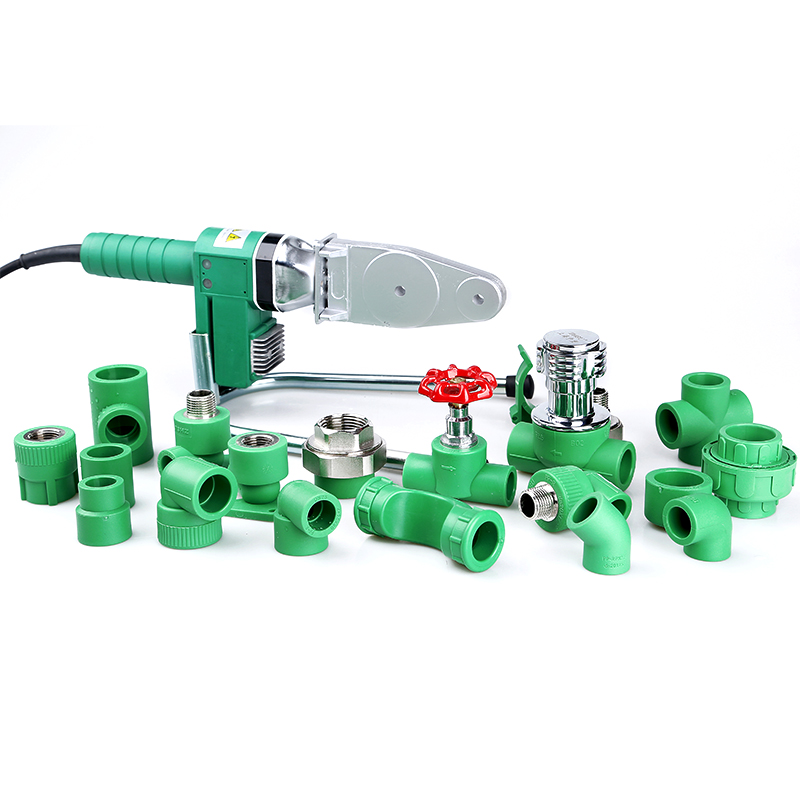In order to avoid the problems of pipe blockage and leakage caused by long-term use of PPR pipe fittings, effective measures need to be taken from multiple aspects such as installation, maintenance, and use.
PPR pipe fittings usually adopt hot melt connection technology. During installation, it is necessary to ensure that the temperature, pressure and time of the connection are properly controlled to avoid loose or unsealed connections, which may lead to leakage problems.
Avoid excessive bending and stretching: Avoid excessive bending or stretching of pipes during installation, especially at pipe joints. Excessive bending will affect the flowability of pipes, increase internal resistance, and even cause pipe rupture.
During installation, ensure that the PPR pipe fittings used have no defects such as cracks and damage. Damaged pipe fittings are prone to leakage or deformation during use.
During installation, pay attention to cleaning the inside of the pipe to avoid impurities, dust or dirt from entering the pipe and causing blockage.
Ensure that the pipe design is reasonable to avoid poor water flow, especially in drainage systems. During design, ensure that the pipe has an appropriate slope to ensure smooth water flow and avoid blockage caused by water accumulation or water retention.
The diameter of the pipe should be reasonably selected according to the requirements of flow and pressure. Too small pipes are prone to poor water flow, water accumulation and even blockage.
When designing, avoid areas with long-term static water flow, because static water areas are more likely to accumulate impurities and mineral deposits, leading to blockage. The drainage system of the pipe can be appropriately increased to ensure water circulation.
Regularly check whether there is leakage at the joints of the pipes, especially the hot-melt joints. If there are signs of water seepage, the damaged pipes should be repaired or replaced immediately.
Clean the inside of the PPR pipe regularly to avoid the accumulation of sediment or minerals. Especially for household water supply pipes, scale is prone to form in areas with hard water, causing pipe blockage. Professional pipe cleaning tools and cleaning agents can be used to regularly remove sediments in the pipes.
Check whether the support of the pipe is stable to avoid uneven force, deformation or falling off of the pipe due to improper support. Regularly check whether the fixing device of the pipe is loose to prevent the displacement of the pipe.

Avoid long-term high water pressure on the pipe. The pressure resistance of PPR pipe fittings is limited. Excessive pressure can cause deformation or rupture of the pipe, resulting in leakage. The water pressure of the pipe system should meet the design requirements.
PPR pipes have good heat resistance, but extreme temperature changes (such as sudden high or low temperatures) may cause pipe deformation or joint detachment. Avoid overheated or overcooled liquids from entering the pipes to maintain temperature balance.
Avoid external mechanical shocks to the surrounding environment of the pipes, especially in pipe systems installed underground or in walls. External forces may cause PPR pipe fittings to rupture or joints to loosen.
Although PPR pipe fittings have strong corrosion resistance, long-term exposure to UV rays may cause aging. Make sure that the pipe system is not directly exposed to sunlight or contact with chemicals. If installed outdoors, pipe protective sleeves or shielding measures can be used.
Regularly check whether there is water accumulation in the pipes, especially at the ends or elbows of the pipes. Water accumulation not only increases the burden on the pipes, but may also cause dirt to accumulate, causing blockages.
If the water quality is hard (such as water containing more minerals), consider installing filters or water softening devices in the pipe system to prevent scale from depositing in the pipes and causing blockages.
Avoid large amounts of water use at the same time in the pipe system. Excessive water load may cause excessive pressure in the pipes, resulting in the risk of leakage or rupture.
Some chemical cleaners may corrode or damage PPR pipe fittings. When using, choose a cleaner that meets the requirements of the pipeline and ensure that the cleaner is harmless to the pipe.
The quality of PPR pipe fittings on the market varies. Poor-quality pipe fittings often have lower pressure resistance, heat resistance and corrosion resistance, and are prone to problems in long-term use. Choosing a brand with quality certification and a good reputation can reduce the risk of pipeline failure.
Make sure that the PPR pipe fittings purchased meet national and international quality standards, such as ISO 15874, GB/T 13663 and other certifications to ensure their reliable performance.
If PPR pipe fittings need to be used in a high temperature environment, PPR pipe fittings with a higher high temperature resistance grade should be selected to avoid softening and deformation of the pipe fittings due to high temperature.
In a low temperature environment, the brittleness of PPR pipe fittings may increase, so it should be ensured that the necessary insulation measures are taken during the installation of the pipeline system to prevent the pipe from freezing or bursting.
Regular cleaning, timely maintenance, proper piping system design and ensuring adequate water pressure are the key to extending the service life of PPR pipe fittings and ensuring smooth system operation.

 简体中文
简体中文 English
English русский
русский Español
Español Français
Français عربى
عربى Português
Português 日本語
日本語 italiano
italiano Nederlands
Nederlands Polskie
Polskie












